Molybdenum Deficiency In Cannabis Plants
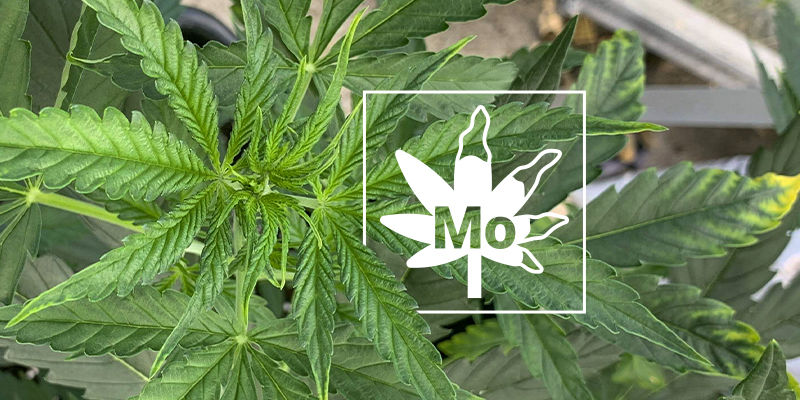
Molybdenum is a natural element that plays an essential role in supporting the healthy growth of all plants, including cannabis. Since molybdenum is particularly important for producing specific enzymes, a molybdenum deficiency can significantly impact the health and development of your cannabis plants. Below we'll teach you exactly how to identify and treat molybdenum deficiencies in cannabis.
What causes molybdenum deficiency
As the name implies, molybdenum deficiencies occur when cannabis plants can't access the molybdenum present in their growing medium. Generally speaking, two main things can interrupt a cannabis plant's access to molybdenum:
❌ Cold temperatures. Cannabis roots function their best at temperatures between 15 and 30°C, with some growers/researchers claiming the sweet spot is somewhere around 24°C. Below 15°C, the rate at which cannabis plants take up nutrients and water via their roots drops significantly, and at 13°C, cannabis roots undergo a mild shock. Nutrient deficiencies can occur when the root zone is exposed to cold temperatures over extended periods as plants struggle to take up nutrients from their medium/fertiliser.
❌ pH imbalance. The optimal pH range for cannabis is 5.8–6.2, depending on your setup and growing style (plants in hydroponic/soilless grows can tolerate slightly more acidic conditions). Outside this range, the availability of macro and micronutrients drops dramatically, resulting in a nutrient deficiency. Sometimes, you may find that your soil is very rich in iron, indicating that it may be too acidic, as iron is more readily available in acidic soils. In contrast, molybdenum is available at higher (i.e. more alkaline) pH levels.
How to recognise a molybdenum deficiency
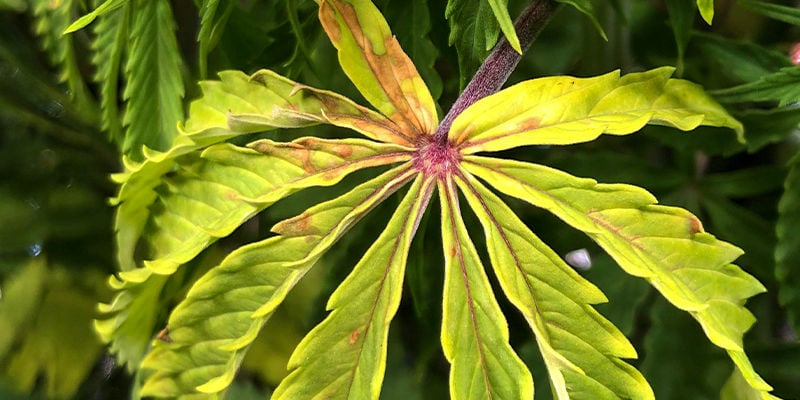
Molybdenum deficiencies aren't very common, but when they do occur, it's important to diagnose and treat them rapidly. Knowing how to tell apart a molybdenum deficiency from other common cannabis nutrient deficiencies can be tricky, but look out for these symptoms:
-
Discolored leaves. Molybdenum is required by a number of enzymes involved in nitrogen feeding. When a cannabis plant doesn't get enough molybdenum, the plant is able to take up nitrate from its medium but can't use it to produce energy. As a result, you may see cannabis plants develop pale green or yellow leaves. Older leaves may also develop burned edges.
-
Stunted growth. Cannabis plants that don't get enough molybdenum will be noticeably less vigorous than healthy plants without a deficiency.
-
Brittle, dying foliage. In more advanced stages, molybdenum deficiencies may cause plants to develop yellow, brittle, and dying foliage, particularly older leaves in the bottom/middle of the plant. This is a direct result of the plant's inability to use nitrogen and its response by transporting nitrogen stores around to new growth sites, leaving older leaves to wither and die.
How to prevent a molybdenum deficiency
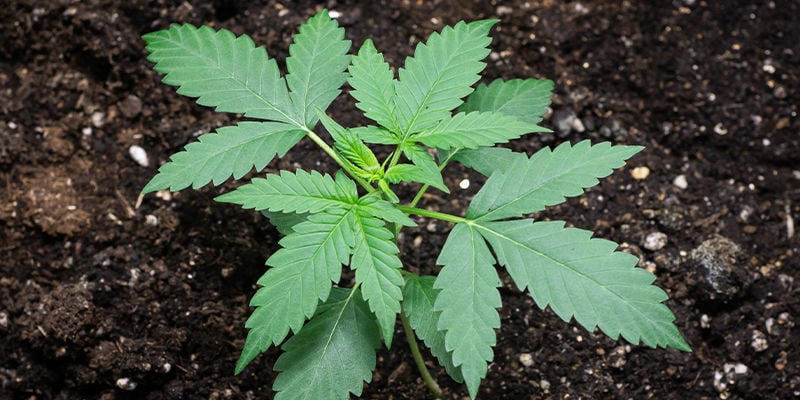
The best defence is a good offence—this age-old adage rings true for many things, including preventing nutrient deficiencies in cannabis. When it comes to preventing molybdenum deficiencies, we recommend taking the following precautions:
✅ Start your grow with high-quality organic soil and fertilisers. The quality of the medium and fertilisers you use to grow cannabis will directly impact the health of your plants and, come harvest time, the quality of the bud they yield. At Zamnesia, we always recommend cannabis growers start their grows off right with a high-quality organic grow mix (check our recipe for organic super soil) and feed their plants with only natural fertilisers such as our Monster Bud Mix. Working with organic substrates and fertilisers reduces the risk of overfeeding and pH fluctuations, while simultaneously creating a rich organic environment for your plants' roots to thrive in.
✅ Keep your growing environment optimal. If you grow cannabis in a tent or room, take advantage of your unique position to create the perfect growing environment for your plants. Pay close attention to the temperature, relative humidity, and airflow in your grow room, as sudden or prolonged fluctuations can stress your plants and affect how they take up water and nutrients like molybdenum.
✅ Keep tabs on pH. As we saw earlier, pH fluctuations are one of the main causes of molybdenum deficiencies (as well as other problems). Invest in a pH testing kit and check the pH of your water, nutrients, and run-off regularly to catch any pH fluctuations early before they disrupt the growth of your plants more seriously.
A note on organics: Using organic soil and nutrients helps create a healthy ecosystem of microbial lifeforms (like beneficial bacteria and fungi) in your growing medium. This not only boosts the growth of your plants but also protects them from pests/pathogens and helps stabilise pH.
How to treat molybdenum deficiency
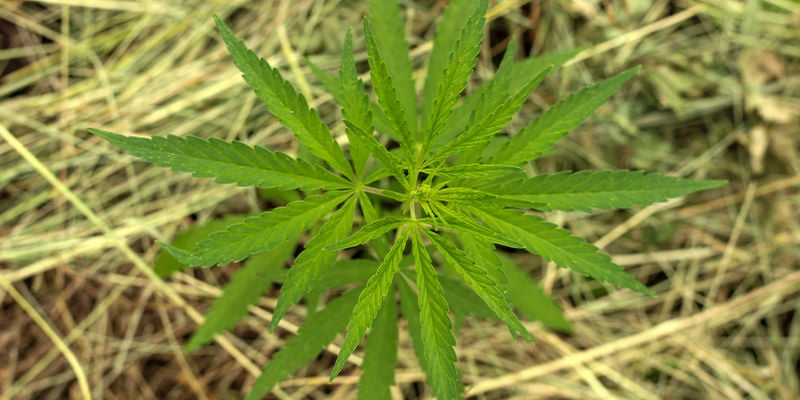
Molybdenum is a micronutrient, meaning cannabis plants only need trace amounts of it in order to grow properly. If you run into a molybdenum deficiency, follow these steps to treat the problem and minimise its impact on the health of your plants.
1️⃣ Identify whether the deficiency is likely caused by a temperature problem or a pH imbalance.
2️⃣ If you suspect temperature to be the issue, increase the temperature in your grow room by:
-
Using air conditioning to heat your tent/room (space and budget permitting, of course).
-
Using heat mats to provide warmth directly to the root zone.
-
Using mulch to insulate the root zone and help stabilise its temperature.
-
Dimming your intake/outtake fans.
-
De-glassing your HID lights to allow more heat from the lights to enter the room/tent.
3️⃣ If you're dealing with a pH issue, do the following:
-
Buy a pH test kit and test your water, nutrients, and the run-off when you water your plants.
-
Use a pH Up/Down agent to adjust the pH of your water or fertiliser and bring it into the optimal range for cannabis (5.8–6.2)
Say goodbye to molybdenum deficiencies
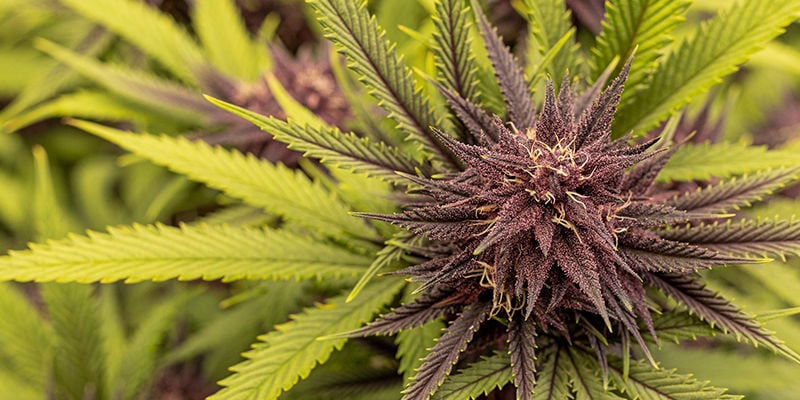
Molybdenum is a vital micronutrient cannabis plants use to produce enzymes to facilitate many processes. While molybdenum deficiencies are rare, they can affect cannabis plants and impact their ability to feed properly, resulting in poor health and stunted growth. Use the information in this post to clearly identify molybdenum deficiencies and address them quickly before your plants suffer any serious health effects.









 United States
United States













